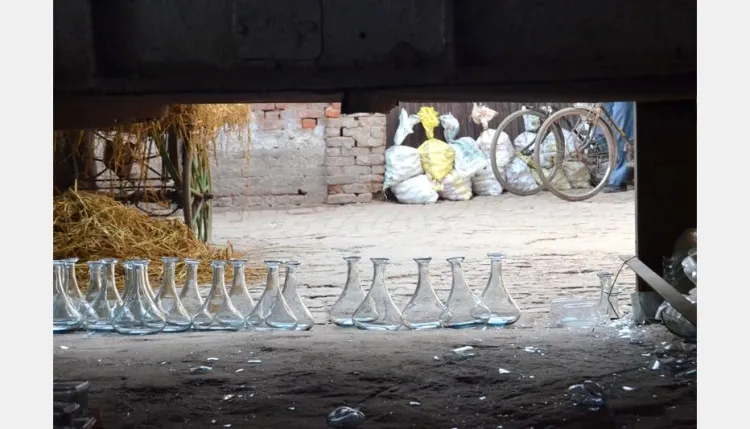Exploring the Versatility and Elegance of Glasswork...!!!
Glasswork is a captivating and versatile craft that combines artistry with technical skill. From timeless stained glass windows to cutting-edge architectural glass, the designs and techniques in glasswork continue to inspire and delight.

Glasswork is an age-old and versatile craft that involves shaping and manipulating glass to create a diverse array of artistic and functional items. From intricate stained glass windows to elegant glass sculptures, glasswork encompasses a range of techniques and designs that have evolved over thousands of years.
A Glimpse into the History of Glasswork
Glassmaking dates back to around 3500 BCE in Mesopotamia and Egypt, where the first glass beads and vessels were created. The craft spread to the Roman Empire, where the invention of glassblowing revolutionized glass production, enabling the creation of more complex shapes and designs. Over the centuries, glasswork has been influenced by various cultures and artistic movements, leading to the rich diversity of styles and techniques we see today.

Fundamental Techniques in Glasswork
-
Glassblowing:
-
Glassblowing involves inflating molten glass into a bubble using a blowpipe. This technique allows for the creation of a wide range of shapes, from simple vases to intricate sculptures. Skilled glassblowers can manipulate the glass while it's still hot, adding details and textures.
-
-
Stained Glass:
-
Stained glass involves cutting colored glass into pieces and joining them with lead strips to create decorative windows and panels. This technique reached its zenith during the Gothic period, with magnificent windows adorning cathedrals and churches.
-
-
Lampworking (Torchworking):
-
Lampworking uses a torch to melt and shape glass rods and tubes. This technique is often employed to create small, detailed objects like beads, figurines, and scientific instruments.
-
-
Glass Casting:
-
In glass casting, molten glass is poured into a mold to create a specific shape. This method is commonly used for larger sculptures and architectural elements.
-
-
Fusing and Slumping:
-
Fusing involves melting pieces of glass together in a kiln to create a single, solid piece. Slumping uses a mold to shape the glass as it softens in the kiln. These techniques are often utilized for making glass bowls, plates, and decorative items.
-
Popular Designs in Glasswork
-
Stained Glass Windows:
-
Stained glass windows are renowned for their vibrant colors and intricate patterns. Common designs include religious scenes, floral motifs, and abstract patterns. These windows are often found in churches, historic buildings, and homes.
-
-
Glass Sculptures:
-
Glass sculptures can range from delicate figurines to large, abstract installations. Artists like Dale Chihuly have popularized contemporary glass sculptures with their bold colors and dynamic forms.
-
-
Glass Jewelry:
-
Glass beads and pendants are popular in jewelry making. Techniques like lampworking and fusing allow artists to create unique, intricate designs. Murano glass from Italy is celebrated for its exquisite glass jewelry.
-
-
Architectural Glass:
-
Architectural glass includes elements like glass walls, windows, and skylights. Modern architectural glass often features innovative designs, such as etched patterns, frosted finishes, and colored tints.
-
-
Glassware:
-
Functional glassware includes items like drinking glasses, bowls, and vases. Designs can range from simple and utilitarian to ornate and decorative. Blown glass and fused glass techniques are commonly employed in glassware production.
-

The Creative Process in Glasswork
-
Design and Planning:
-
The initial step in creating a glasswork piece involves designing and planning. Artists sketch their ideas and determine the techniques and materials needed. This phase requires a great deal of creativity and precision.
-
-
Material Selection:
-
Choosing the right type of glass is crucial. Different types of glass have varying properties, such as color, transparency, and melting point. Artists select materials that best suit their design and technique.
-
-
Execution:
-
The actual creation process varies depending on the technique used. Whether blowing, cutting, melting, or molding, each method requires skill and expertise. Artists often use specialized tools and equipment to shape and manipulate the glass.
-
-
Finishing Touches:
-
After the main shaping is complete, artists add finishing touches. This can include polishing, etching, or adding details with other materials. The finishing process enhances the appearance and durability of the piece.
-
Modern Innovations in Glasswork
The world of glasswork continues to evolve with new technologies and materials. Innovations like dichroic glass, which changes color depending on the lighting, and smart glass, which can change transparency with electrical input, are expanding the possibilities for glass artists and designers.
Glasswork is a captivating and versatile craft that combines artistry with technical skill. From timeless stained glass windows to cutting-edge architectural glass, the designs and techniques in glasswork continue to inspire and delight. Whether you appreciate the beauty of a delicate glass ornament or the grandeur of a glass installation, the art of glasswork offers endless possibilities for creativity and expression.
What's Your Reaction?

















